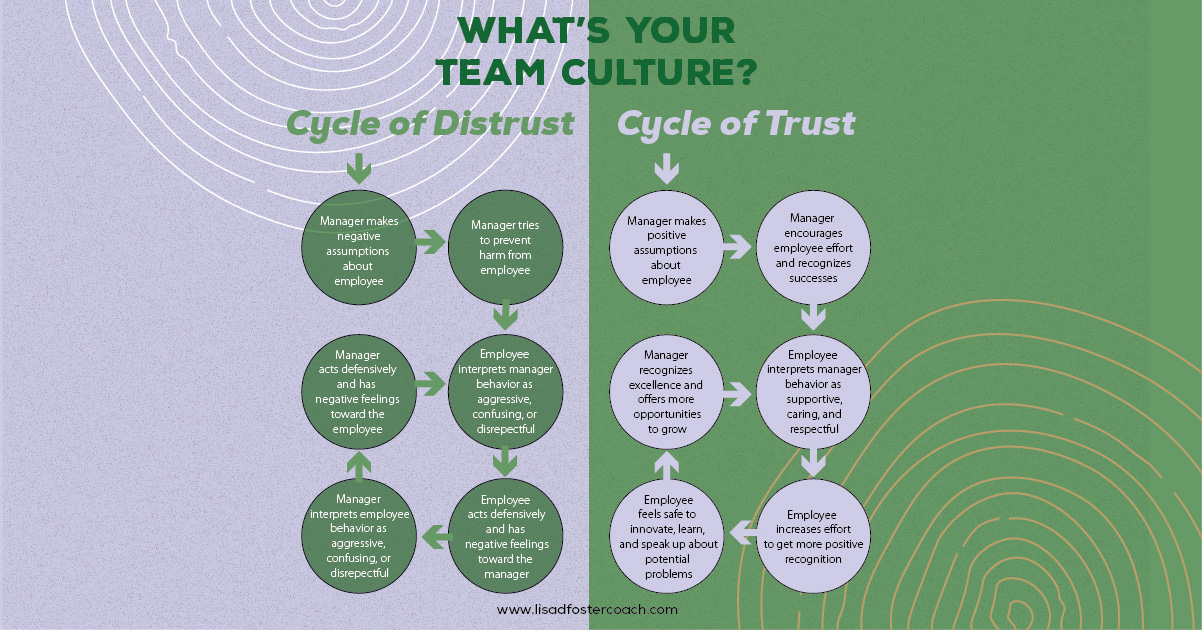If you want to build a high performing company, start by building a high trust culture through emotional intelligence.
Some people think employees are inherently untrustworthy, lazy and self-serving. Others believe employees are inherently trustworthy and motivated by a sense of pride in their work.
Who is right?
Research says: they are both right.
As it turns out, the assumptions that managers make about employees determines the outcome. If you start with an emotional intelligence approach and build trust, you get a culture that promotes high engagement and performance. If you start with an authoritarian approach built on fear, you initiate a cycle of distrust that distracts from and lowers overall performance.
High Trust Causes High Performance
Trust actually causes people to perform better (see Ryan and Oestrich, Sucher and Gupta, Gallup, and this excellent research from Harvard). Trust encourages over-and-above behaviors that every organization wants but can’t demand: high engagement and putting the organization’s needs over the individual. In a culture of trust, employees willingly participate in the flow of information, innovation, and change.
Trust comes from an emotional intelligence approach to management. When managers show they care about and listen to team members, employees feel valued and enjoy a sense of safety and belonging. In response, they take pride in their work and are willing to put in the extra effort required to reach common goals. In the virtuous cycle of trust, even ambitious goals are possible.
Five Characteristics of High Performance Companies
Meta-studies of top quartile companies reveal five common characteristics of high performing organizations.
- A positive corporate identity that both employees and the community appreciate.
- Equal respect for employees as for customers and shareholders.
- Enthusiasm for improvements and new opportunities.
- Leadership that models, supports, and facilitates core values.
- Leadership with the capacity to make change and inspire progress.
The key element underlying all these characteristics is trust.

Case studies of companies that survived existential threats and went on to become dominant in their industry demonstrate the advantages of a culture of trust. Intel’s culture of trust became a competitive advantage as it beat the competition to become the world’s largest chip maker. Tylenol regained consumers’ trust after cyanide attacks left seven people dead and recovered their full market share. When a racist incident happened, Starbucks CEO took responsibility and shut down 8000 stores for training.
Distrust Causes Low Performance
Similarly, distrust causes people to perform worse than they are. As Ryan and Oestreich have documented, leaders who assume that employees are lazy, self-serving, or incompetent, themselves initiate a cycle of fear and distrust.

When managers act authoritatively, employees feel threatened and belittled. As a result, they focus on not getting into trouble. Managers and employees become pitted against each other. Power games and politics begin to dominate, leading to behaviors like covering up mistakes, revenge, stonewalling, factions, and territorialism. The harder administrators try to enforce performance, the more resistance they get.
Famous corporate meltdowns like Enron, Miramax (Harvey Weinstein), Theranos, and Bernie Madoff, all have in common a corporate culture steeped in authoritarianism, control, secrecy, and fear.

Even good companies can fall into patterns of distrust. By the early 2000s, NASA was more focused on budgets and deadlines than safety. They ignored engineers who warned about foam debris and O rings, the causes of the Challenger and Columbia disasters. More recently, Boeing ignored engineers who warned about the dangers of the navigation system for the 737 Max. When upper managers don’t trust people on the front lines, performance inevitably falls.
Using Emotional Intelligence to Build Trust on Your Team
Most organizations fall in the middle between high trust and low trust cultures. In these organizations, managers can vary widely in their trust of others and leadership style. Even one good manager can have a significant positive effect.
Here are three tips for building a high trust, high performance leadership style based on emotional intelligence.
- Know your strengths and accept your weaknesses. Good leaders have the confidence to know their strengths and lean into them. They also have the humility to know their weaknesses and compensate for them. If you can’t recognize your weaknesses, they are bound to become triggers for aggressive behavior. Learn to take feedback and to listen to contrary opinions respectfully. Consider other points of view before stating your own or making a decision.
- Build emotional self-awareness. If you are not aware of how your behavior is affecting others, you are likely to be offending people in ways you don’t recognize. To build more emotional self-awareness, start by noticing shifts in your own emotions as you move throughout your day. Take time to identify any changes in how you feel and trace your emotion back to the incident or thought that prompted it. Then, turn your attention to analyzing what others are feeling and why. When you can tune into what causes people to feel empowered and what causes them to feel small, you will improve your ability to motivate them.
- Be a leader, not a boss. A boss defines their job as telling team members what to do and judging whether they have done it well or not. A boss spends most of their time talking, judging, and holding people accountable. A boss usually speaks first and expects others to fall in line with their opinion. A leader defines their job as inspiring team members to be their best and giving them the resources they need to succeed. A leader spends most of their time listening, recognizing excellence, and helping people overcome obstacles. A leader listens to other opinions first and is often the last to speak after considering and learning from other points of view. Leaders beat bosses in performance and results every time.
Do You Expect High Performance from Your Team?
Expectations are powerful drivers of human motivation. Expect a little from your team, and you’ll get a little. Expect a lot, and they will give you their best and highest performance.
